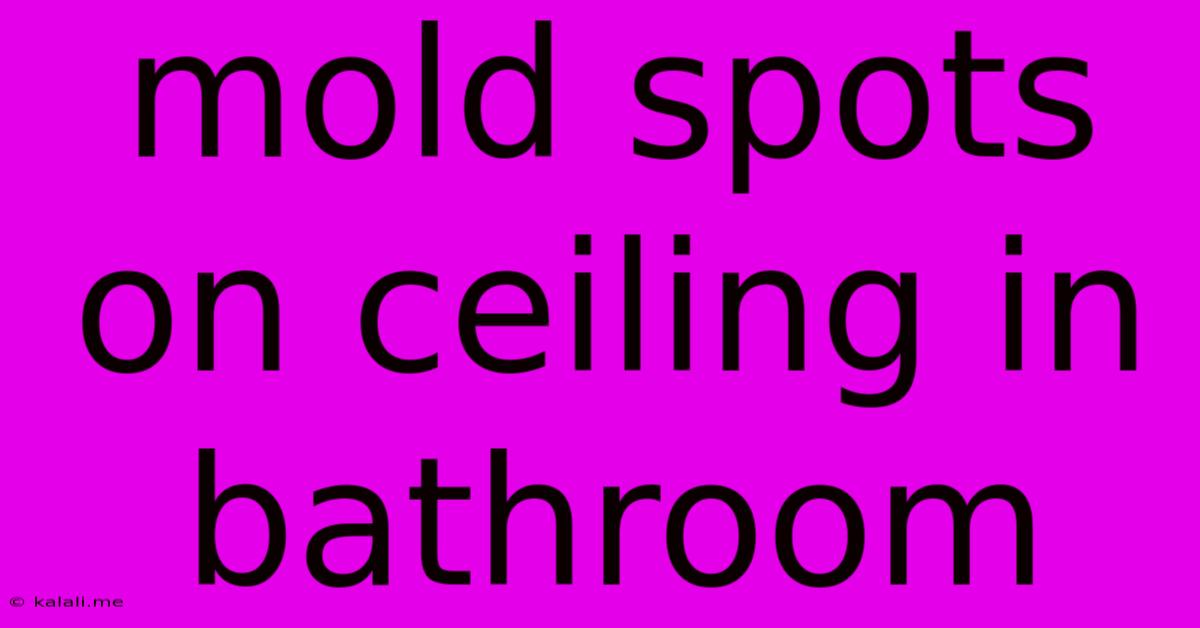Mold Spots On Ceiling In Bathroom
Kalali
May 28, 2025 · 3 min read

Table of Contents
Mold Spots on Your Bathroom Ceiling: Identification, Causes, and Remediation
Discovering mold spots on your bathroom ceiling is unsettling, but it's a common problem with straightforward solutions. This article will guide you through identifying, understanding the causes, and effectively removing mold from your bathroom ceiling, preventing future growth, and protecting your health. This guide covers everything from recognizing the tell-tale signs to employing safe and effective remediation techniques.
Mold in bathrooms thrives in humid environments. Understanding its causes is the first step towards eliminating it permanently. Ignoring mold can lead to health problems and structural damage, so proactive treatment is crucial.
Identifying Mold on Your Bathroom Ceiling
Mold manifests in various ways, often appearing as discolored patches. These spots might be:
- Black: A classic indicator, often associated with Stachybotrys chartarum, commonly known as "black mold." However, many other types of mold can also be black.
- Green: Another common color, indicating various mold species.
- White or Gray: While less alarming visually, these colors can still indicate the presence of mold and should not be ignored.
- Fuzzy or Slimy Texture: The texture of the mold can also help with identification, but this shouldn't be the sole determining factor.
Important Note: Never attempt to touch or disturb mold without proper safety precautions. Some molds can release spores that are harmful if inhaled.
Causes of Mold on Bathroom Ceilings
High humidity is the primary culprit behind mold growth in bathrooms. Several factors contribute to this:
- Poor Ventilation: Lack of proper ventilation allows moisture to accumulate, creating the perfect breeding ground for mold. Exhaust fans are crucial.
- Leaking Pipes or Fixtures: Leaks, even small ones, can cause significant moisture buildup over time. Regularly check pipes and faucets for leaks.
- Showering Habits: Long, hot showers release a considerable amount of moisture into the air.
- Condensation: Cold surfaces, such as pipes or windows, can collect condensation, leading to mold growth.
- Lack of Regular Cleaning: Failing to clean and dry the bathroom regularly allows moisture and mold spores to accumulate.
Effective Mold Removal from Your Bathroom Ceiling
Before starting any mold removal, protect yourself: Wear a respirator mask, gloves, and eye protection. Open windows to ensure good ventilation. For larger infestations or if you’re unsure about tackling it yourself, it's best to consult a professional mold remediation specialist.
For small mold spots (less than 10 square feet), you can attempt remediation yourself using these steps:
- Prepare the Area: Cover the floor and surrounding areas with plastic sheeting to prevent mold spore spread.
- Scrub the Affected Area: Use a solution of warm water and mild detergent (avoid bleach for some types of mold as it can spread spores). Scrub gently to remove the mold.
- Rinse Thoroughly: Rinse the area with clean water to remove all traces of the cleaning solution.
- Dry Completely: Allow the area to dry completely. You can use a fan to speed up the drying process.
- Apply a Mold Inhibitor (Optional): Applying a mold inhibitor to the cleaned area can help prevent future growth.
Preventing Future Mold Growth
Preventing mold is far easier than removing it. Here are some preventative measures:
- Install and Use an Exhaust Fan: Ensure your bathroom has a properly functioning exhaust fan and use it during and after showers.
- Fix Leaks Promptly: Address any leaks in pipes or fixtures immediately.
- Improve Ventilation: Open a window if possible to increase air circulation.
- Regular Cleaning: Clean your bathroom regularly, paying special attention to areas prone to moisture buildup.
- Keep Humidity Low: Use a dehumidifier if necessary to maintain a low humidity level.
By following these steps, you can effectively address mold spots on your bathroom ceiling and prevent future occurrences, ensuring a healthy and mold-free bathroom. Remember, safety first! If you’re uncomfortable tackling this yourself, seeking professional help is always the best option.
Latest Posts
Latest Posts
-
Can I Separate A Website From A Multisite Site
May 30, 2025
-
Can You Run Electrical Along A House
May 30, 2025
-
Best Hosting Provider For Sensitive Data
May 30, 2025
-
Show Where Protagonist Is A Merceranry
May 30, 2025
-
We Are Still Have Trouble With
May 30, 2025
Related Post
Thank you for visiting our website which covers about Mold Spots On Ceiling In Bathroom . We hope the information provided has been useful to you. Feel free to contact us if you have any questions or need further assistance. See you next time and don't miss to bookmark.